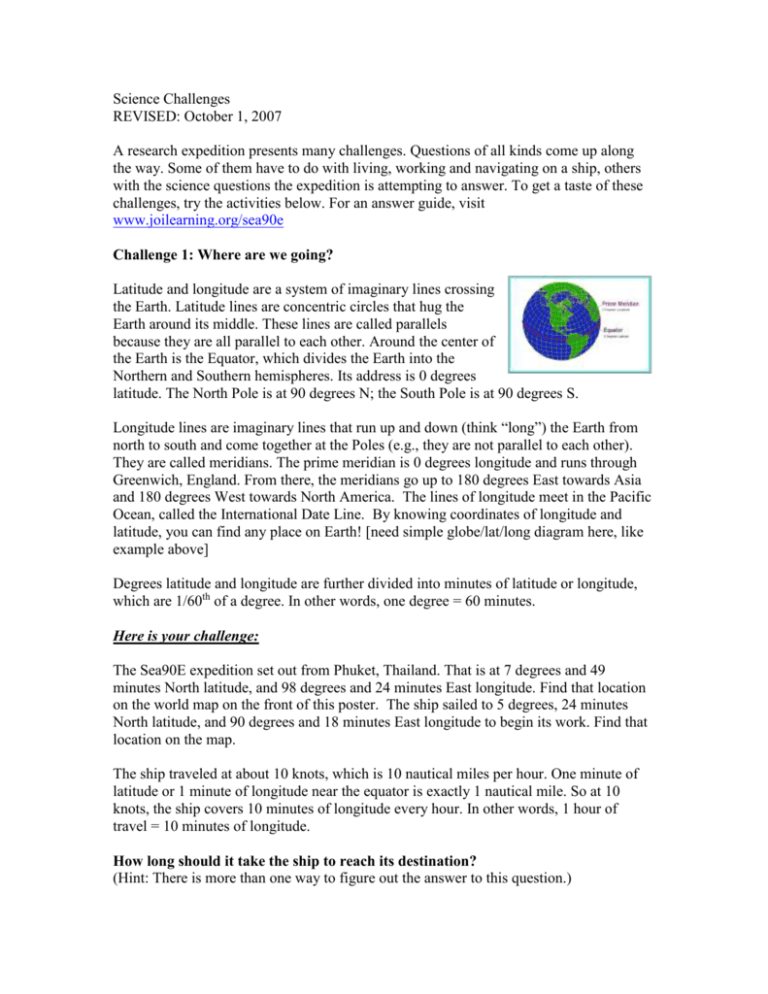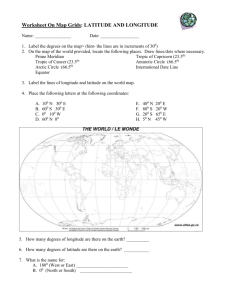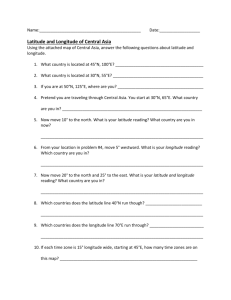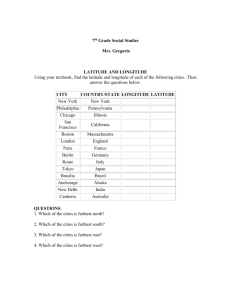science challenge questions - Consortium for Ocean Leadership
advertisement

Science Challenges REVISED: October 1, 2007 A research expedition presents many challenges. Questions of all kinds come up along the way. Some of them have to do with living, working and navigating on a ship, others with the science questions the expedition is attempting to answer. To get a taste of these challenges, try the activities below. For an answer guide, visit www.joilearning.org/sea90e Challenge 1: Where are we going? Latitude and longitude are a system of imaginary lines crossing the Earth. Latitude lines are concentric circles that hug the Earth around its middle. These lines are called parallels because they are all parallel to each other. Around the center of the Earth is the Equator, which divides the Earth into the Northern and Southern hemispheres. Its address is 0 degrees latitude. The North Pole is at 90 degrees N; the South Pole is at 90 degrees S. Longitude lines are imaginary lines that run up and down (think “long”) the Earth from north to south and come together at the Poles (e.g., they are not parallel to each other). They are called meridians. The prime meridian is 0 degrees longitude and runs through Greenwich, England. From there, the meridians go up to 180 degrees East towards Asia and 180 degrees West towards North America. The lines of longitude meet in the Pacific Ocean, called the International Date Line. By knowing coordinates of longitude and latitude, you can find any place on Earth! [need simple globe/lat/long diagram here, like example above] Degrees latitude and longitude are further divided into minutes of latitude or longitude, which are 1/60th of a degree. In other words, one degree = 60 minutes. Here is your challenge: The Sea90E expedition set out from Phuket, Thailand. That is at 7 degrees and 49 minutes North latitude, and 98 degrees and 24 minutes East longitude. Find that location on the world map on the front of this poster. The ship sailed to 5 degrees, 24 minutes North latitude, and 90 degrees and 18 minutes East longitude to begin its work. Find that location on the map. The ship traveled at about 10 knots, which is 10 nautical miles per hour. One minute of latitude or 1 minute of longitude near the equator is exactly 1 nautical mile. So at 10 knots, the ship covers 10 minutes of longitude every hour. In other words, 1 hour of travel = 10 minutes of longitude. How long should it take the ship to reach its destination? (Hint: There is more than one way to figure out the answer to this question.) Challenge #2: Bathymetry An important goal of a site survey cruise is gathering information for creating bathymetry maps. What is bathymetry? It is a word that comes from two Greek words, “bathy,” meaning deep, and “metry,” meaning measure. So bathymetry means taking measurements of water’s depth. Bathymetry maps are like topographic maps of the ocean floor. They tell you how deep the water is at any particular location. Here is your challenge: Look at the chart above. This is an actual chart of the 90E Ridge. There are three lines on the chart: Line A, Line B, and Line C. Each of these lines is a path that the ship took across the ridge as it conducted its survey. Like contour lines on a topographic map, each line represents the same depth of water along that line. As the color becomes darker, the water becomes deeper. For example, the very dark blue areas are all over 5000 meters (16,404 feet) deep. Your challenge: 1. Look at the data set below and see if you can determine which line the data represents. Each depth is for a longitude, shown at the top and bottom of the chart. Degrees Longitude 84 85 86 87 88 89 90 91 92 Depth (meters below sea level) Feet (below sea level) -4403 -4860 -3905 -2837 -3159 -4202 -4500 -5559 -5309 Circle your answer: -14,446 -15,945 -12,812 -9,308 -10,364 -13,786 -14,764 -18,238 -17,418 Line A Line B Line C 2. Create a data chart like this for each of the other two lines. 3. Using the two data sets, create one line graph. When you are done, these graphs will give you a cross-section view of the underwater mountains! Challenge #3 Where to Dredge? The research ship Revelle used a technique called dredging to collect rock samples from seafloor sites along the 90E Ridge. The dredge onboard Revelle is called a basket dredge because it is essentially a large “basket” consisting of a net of metal chains suspended from a metal frame. [insert photo]The dredge is large enough to collect over 454 kg (1000 pounds) of rock! To collect samples, technicians suspend the dredge from a strong metal cable over a pulley and out into the water. The weight of the empty dredge is over 181 kg (400 pounds). The technicians then attach a “pinger” to communicate back to ship, and a winch operator lets out enough cable for the dredge to be lowered 200m (656 ft) from the seafloor. Control of the winch is then handed over to a Resident Technician in the computer lab, where the cable is let out via remote control until the dredge reaches the seafloor. The captain drives the ship slowly to drag the dredge along the seafloor as it gathers rocks into the basket. When the team brings the dredge basket back on deck, researchers take the rocks out and sort them by type. Scientists and technicians weigh, wash, and describe those rocks, and even saw some of them in half to see what they look like on the inside. When looking for an interesting dredge site, the science team looks for a few important characteristics in the seafloor. They look for a smooth upslope along a seamount that may have been a volcanic site. If the location is very steep, it is sometimes easier to pull the dredge up the slope to “scoop up” the rocks. Most of the time, they try to avoid spikes or cliff locations since it is difficult to keep the cable from becoming snagged or tangled. They also tend to avoid smooth bottom surfaces, since there is usually more sediment there than volcanic rock. Your challenge: Look at the map below. Each of the named sites is a possible dredge location for the expedition. If you were the Resident Technician, where would you dredge? Why there? What site might you choose to skip? Write a short paragraph explaining your choices.









